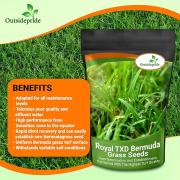
Bermuda grass is susceptible to a variety of fungal diseases including brown patch, dollar spot, leaf spot, phythium, fairy rings, and spring dead spot. While individual diseases appear at different time of the year (depending upon weather), it is almost impossible to predict when your lawn will be afflicted. In many cases, a disease will come and go without your ever knowing it. Since fungal diseases are very difficult to identify it is important to keep a sharp watch for anything abnormal.
In general, fungal diseases appear as brown or damaged patches of grass with smooth outlines. If you find a patch that fits this description, don't run out and spray the entire lawn with a fungicide. Wait to see if the patch is damaged grass expands over the next day or two. It is likely that the fungal disease has already run its course. An "active" patch of diseased turf will grow and expand concentrically over a couple of days. Grass plants along the outline of the damaged patch will leave the most telling signs: wilted plants, shriveled leaves, or discolored leaf blades. Once you have located one of these areas, spray with a lawn fungicide approved for use on Bermuda grass.
In your lawn has a history of fungal problems you may want to renovate the dead areas and then spray preventatively with a lawn fungicide the following year so that the disease does not recur. Follow the directions on the product label explicitly.
Many fungal diseases are exacerbated by water. This is especially true with fungal diseases that are prevalent in the spring and fall when daytime air temperatures are 60 to 80 degrees and nighttime air temperatures are around 60 degrees. During these critical times do not irrigate unless it is necessary. When needed, water on a sunny day when moisture will evaporate quickly from grass leaves. If there is a daytime watering ban in effect for your area, irrigate immediately before dawn.


































